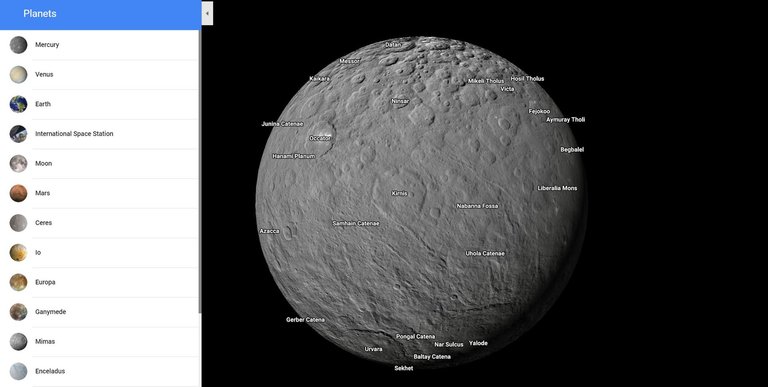
Source
By now, it's clear that we're committed to permanently establishing ourselves on the Moon, and that it will be sooner than we expect. We continually see news of successful lunar missions and the development of innovative vehicles, habitats, and resource extraction techniques that will make life easier for future colonists on our satellite.
A estas alturas resulta indudable que estamos empeñados en establecernos de forma permanente en la Luna y que será más pronto de lo que esperamos. Continuamente vemos noticias de misiones lunares exitosas y desarrollos de vehículos, hábitats y técnicas innovadoras de obtención de recursos, que facilitarán la vida a los futuros colonos de nuestro satélite.
NASA, in collaboration with the Italian Space Agency, has achieved a significant milestone by capturing and tracking Global Navigation Satellite System (GNSS) signals on the lunar surface. This breakthrough was achieved by the Lunar GNSS Receiver Experiment (LuGRE), which was carried to the Moon by Firefly Aerospace's Blue Ghost lander on March 2, 2025.
La NASA, en colaboración con la Agencia Espacial Italiana, ha logrado un hito significativo al captar y rastrear señales del Sistema Global de Navegación por Satélite (GNSS) en la superficie lunar. Este avance se consiguió mediante el Experimento del Receptor GNSS Lunar (LuGRE), que fue transportado a la Luna por el módulo de aterrizaje Blue Ghost de Firefly Aerospace el 2 de marzo de 2025.

Source
LuGRE is a device designed to receive signals from the GPS (United States) and Galileo (Europe) constellations. Following landing, operators at NASA's Goddard Space Flight Center began science operations, and on March 3, it was confirmed that LuGRE had successfully acquired and tracked GNSS signals on the lunar surface, approximately 362,000 kilometers from Earth.
LuGRE es un dispositivo diseñado para recibir señales de las constelaciones GPS (Estados Unidos) y Galileo (Europa). Tras el aterrizaje, los operadores en el Centro de Vuelo Espacial Goddard de la NASA iniciaron operaciones científicas, y el 3 de marzo se confirmó que LuGRE había adquirido y rastreado con éxito señales GNSS en la superficie lunar, a aproximadamente 362,000 kilómetros de la Tierra.
During its journey to the Moon, LuGRE also set records for receiving GNSS signals at great distances. On January 21, it captured signals 337,000 kilometers from Earth, surpassing previous records. Later, on February 20, in lunar orbit, it received signals 390,000 kilometers away.
Durante su viaje a la Luna, LuGRE también estableció récords en la recepción de señales GNSS a grandes distancias. El 21 de enero, captó señales a 337,000 kilómetros de la Tierra, superando registros anteriores. Posteriormente, el 20 de febrero, en órbita lunar, recibió señales a 390,000 kilómetros de distancia.

Source
This achievement has important implications for future exploration missions, such as NASA's Artemis program, by enabling spacecraft and vehicles on the Moon to accurately and autonomously determine their position, velocity, and time using ground-based GNSS signals. This could reduce dependence on tracking stations on Earth and improve the efficiency and safety of lunar missions.
Este logro tiene importantes implicaciones para futuras misiones de exploración, como el programa Artemis de la NASA, al permitir que las naves espaciales y vehículos en la Luna determinen de manera precisa y autónoma su posición, velocidad y tiempo utilizando señales GNSS terrestres. Esto podría reducir la dependencia de las estaciones de seguimiento en la Tierra y mejorar la eficiencia y seguridad de las misiones lunares.
The ground-based GPS system is designed to work on our planet, not on the Moon. However, GPS satellite signals extend far beyond Earth. Even so, for more precise lunar navigation, a lunar-specific satellite navigation system, such as a "lunar GPS," with satellites orbiting our moon, would be needed in the future. The European Space Agency (ESA) is already working on a project called Moonlight, which aims to establish a communication and navigation system on the Moon.
El sistema GPS terrestre está diseñado para funcionar en nuestro planeta, no en la Luna. Sin embargo, las señales de los satélites GPS se extienden mucho más allá de la Tierra. Aun así, para una navegación lunar más precisa, en el futuro se necesitaría un sistema de navegación satelital específico para la Luna, como un “GPS lunar”, con satélites orbitando nuestro satélite. La Agencia Espacial Europea (ESA) ya está trabajando en un proyecto llamado Moonlight, que busca establecer un sistema de comunicación y navegación en la Luna.
More information/Más información
https://phys.org/news/2025-03-nasa-successfully-gps-moon.html
https://www.ecoticias.com/hoyeco/carrera-espacial-gps-luna/18576/
I am really optimistic and happy every blessed day to witness this type of progress and one of the things I am really certain of is the fact that it will continue to get better
The kind of progress we're making now only suggests to me that it's a matter of a decade or 2 and we'll be going to the moon and making travel vlogs with it like it's a normal place.
I agree...
Technology is advancing really fast. Not long ago, the idea of humans having GPS on the Moon seemed like pure science fiction. Now, we’re actually making it happen. At this rate, in a few decades, navigating the Moon might be as easy as using Google Maps on Earth
The rewards earned on this comment will go directly to the people( @tsnaks ) sharing the post on Reddit as long as they are registered with @poshtoken. Sign up at https://hiveposh.com. Otherwise, rewards go to the author of the blog post.